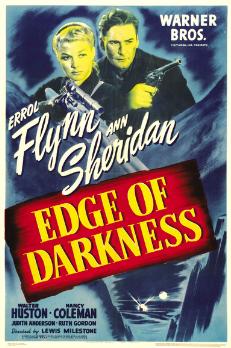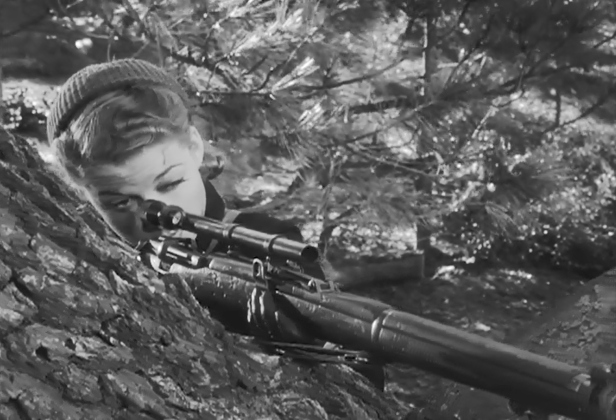Karen (Ann Sheridan), the daughter of a prominent local doctor (Walter Huston), has joined the resistance against Nazi occupation of her small Norwegian town. She’s also in a relationship with Gunnar Brogge (Errol Flynn), the local leader of the resistance.

Unlike Karen, her parents want to remain neutral and try to live life as normally as possible. But others in town, including the doctor’s brother-in-law Kaspar (Charles Dingle), have decided to collaborate with the Nazis.
As unrest grows in the small fishing village, Gunnar, Karen, and their fellow resistance fighters begin to gain more support from the locals, hatching a plan to take back their town.
Lewis Milestone directs 1943’s Edge of Darkness. The film was written by Robert Rossen from a novel by William Woods.
Edge of Darkness focuses on the underground resistance movement in Norway, which isn’t your typical setting for a World War II flick. (They tend to focus on resistance and troop movements elsewhere in Europe, or are set in “exotic” locations like Morocco, in my viewing experience.)
The drama and action here are similar to what they’d be for any other resistance group, but the film easily held my interest, and the change in setting added a little something extra to it.
There’s a nice blend of talk and action as resistance operations are plotted and carried out. The story volleys between moments of intensity and quieter scenes of contemplation. Still, there’s a fair bit of tension and suspense throughout over the fear that the resistance plan will be found out.

Since this isn’t an on-the-battlefield war film, it instead expresses the fears and complications of war as they impact that community, often through on-screen discussion.
Errol Flynn and Ann Sheridan both give good, restrained performances, contributing to the film’s success.
For fans of World War II stories, I would highly recommend Edge of Darkness for a chance to see that era from a slightly different angle. While not as well-remembered as some other portrayals of the period, it’s well worth a watch.
Such an underrated film. I liked this one very much. Sheridan and Flynn are both excellent. A solid film that really keeps you interested and on the edge of your seat.
LikeLike
I have this one in a TCM Errol Flynn collection, but have yet to watch it. Ann is one of my favorites (as I’m sure I’ve mentioned here before), so it’s probably time I gave it a look. And what’s with all the films you’re reviewing that star my favorite actresses…first Carole Landis in ‘Topper Returns’, and now Ann Sheridan. Do you by chance have any Irene Dunne films waiting in the wings?
LikeLike
I don’t have any Irene drafted but I think I have a few of her films saved on the DVR, so keep an eye out!
LikeLike
I stumbled across your FB page today and found a wealth of movies I’d never heard of. This looks great and thank you for sharing :-)
LikeLike
So glad you were able to find a few titles for your to-be-watched list! :) Thanks for stopping by!
LikeLike